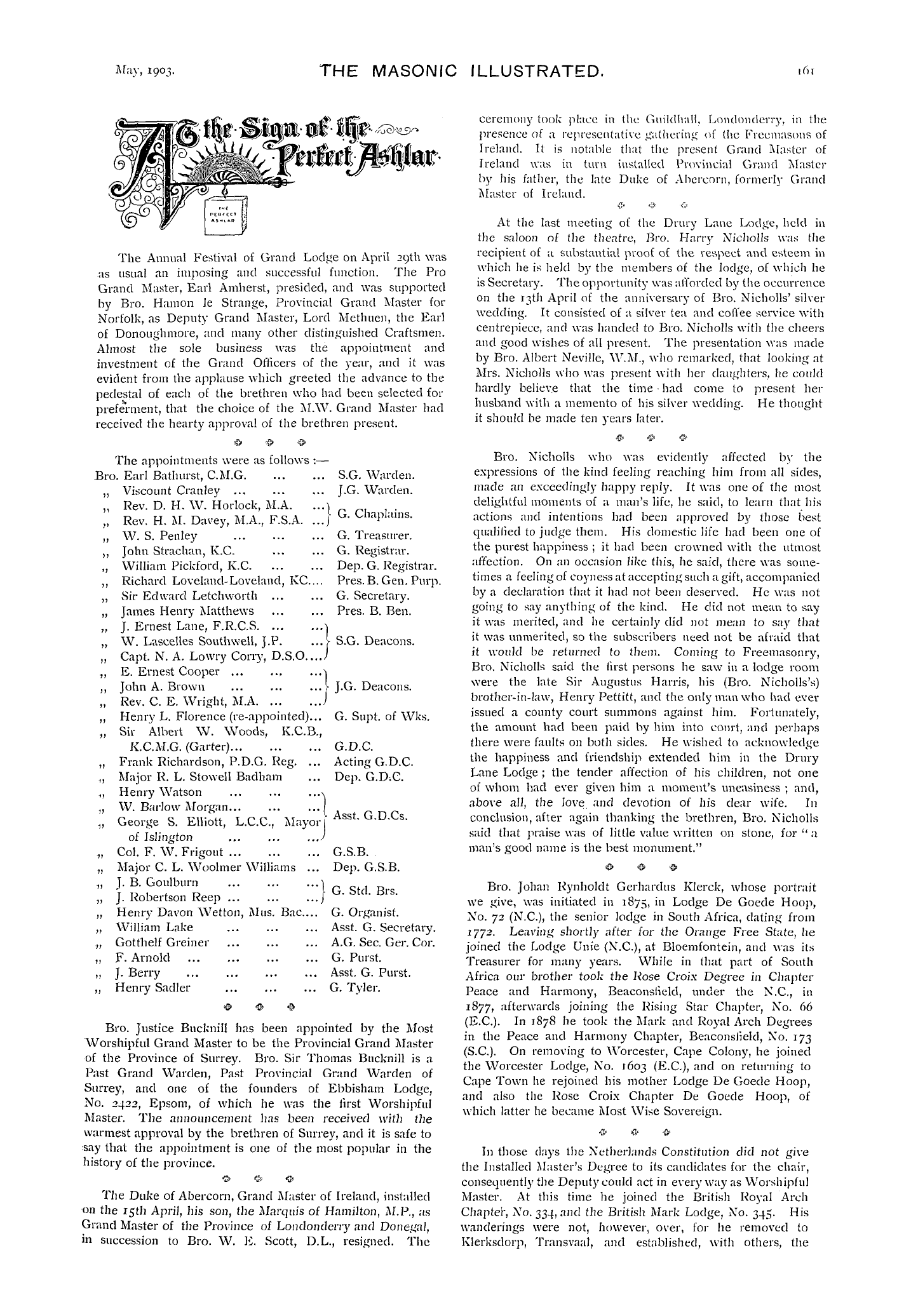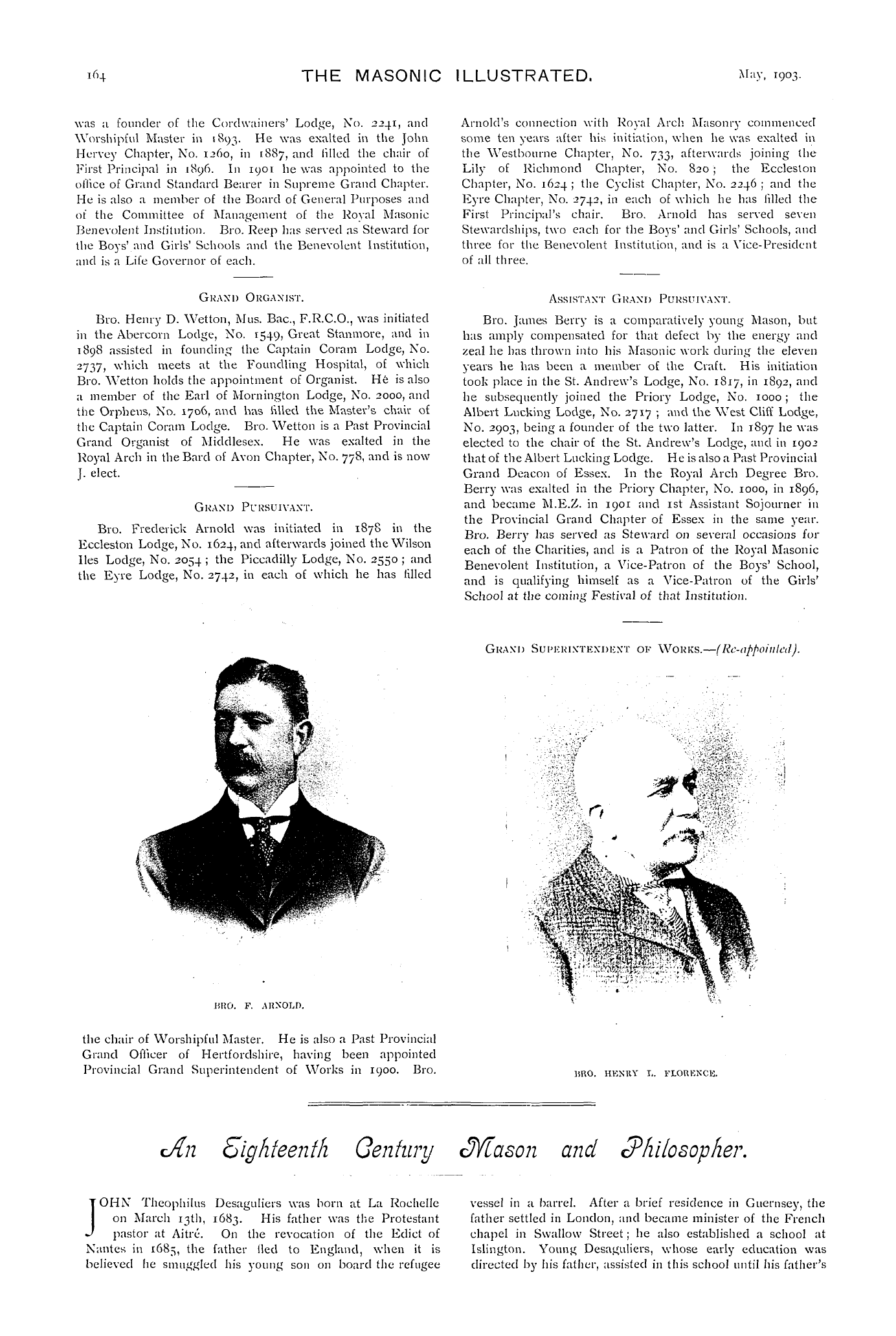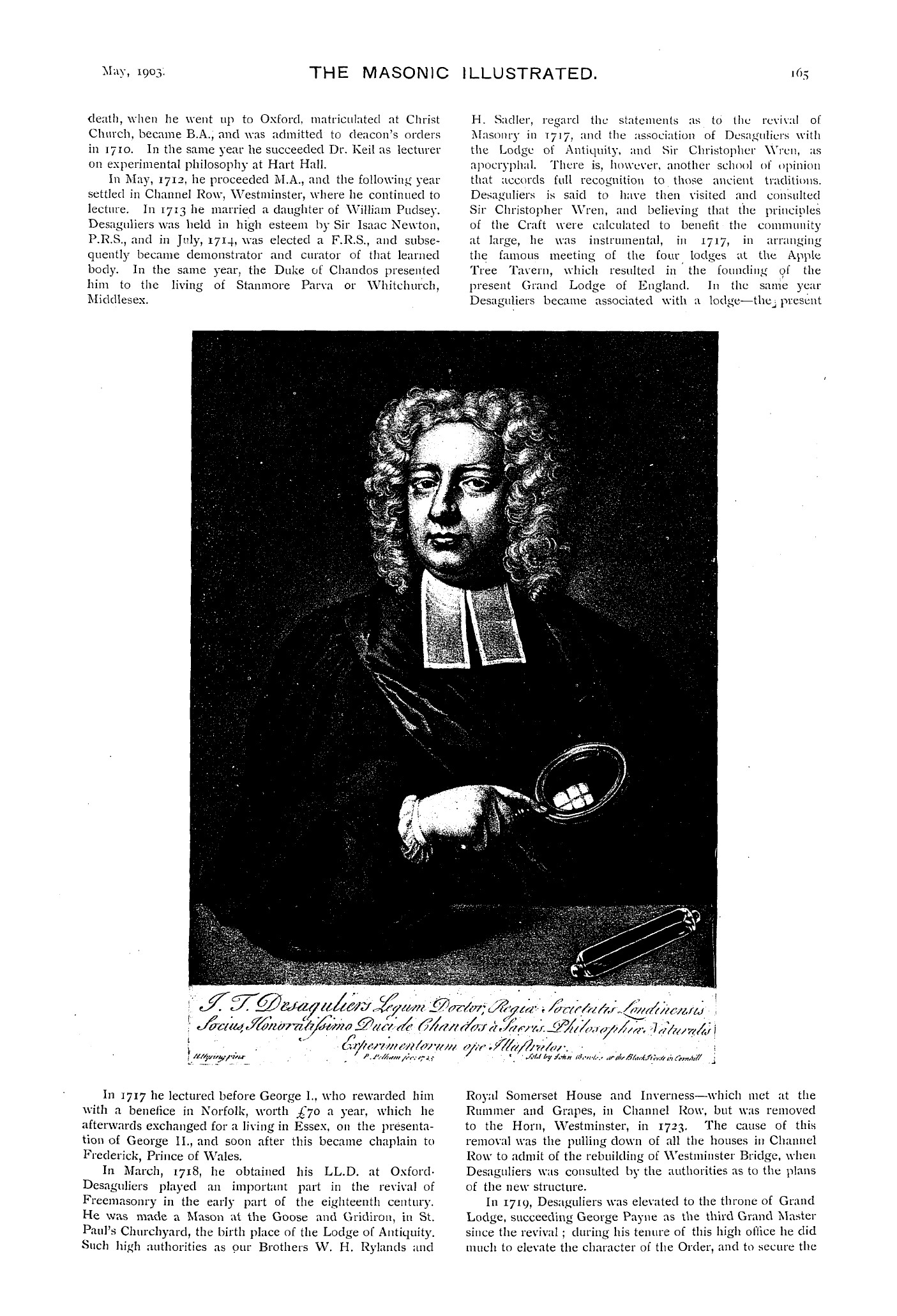Note: This text has been automatically extracted via Optical Character Recognition (OCR) software.
The Province Of Leicestershire And Rutland.
The Province of Leicestershire and Rutland .
SITUATED rijLjlit in the centre of England , the Province of Leicestershire ; ind Rutland is neither one of the largest nor one of the oldest of the Masonic provinces , and yet there are some features of its history , past and present , which are of abiding interest , not only for its own members , but for Masons far and wide .
BHO . SIR F . K . FOWKE , PART ., PROVINCIAL GRAND MASTER , 1 S 31 TO ls . lfi . Although the office of Provincial Grand Master was instituted by the Grand Lodge of England as early as 1726 , it was not until the year 1774 that a " deputation" was
granted by Lord Petre , Grand Master , to Colonel Sir Thomas Fowke , equerry to H . R . H . the Duke of Cumberland , brother of George III ., appointing him to preside over the Craft in Leicestershire . He was succeeded in 1793 by Thomas Boothby Parkyns , Esq ., M . P ., afterwards first Lord Rancliffe ,
who held the office till his death in 1800 . After ten years interregnum , George , second Lord Rancliffe , was appointed to succeed his father , but being a politician lirst and foremost , his Masonic duties were sadly neglected , and although he nominally ruled the province for a period of nearly forty years , the actual work of the office for the latter portion of the time was ably carried out by the Deputy , Sir Frederick
G . Fowke , Bart ., who succeeded him as Provincial Grand Master in 1851 . Sir Frederick died in 18 5 6 , being followed by Earl Howe , who worthily occupied the high position until his death in 1869 . The next Provincial Grand Master was Bro . William Kelly , beloved by all who knew him , who resigned after three years of service , and was succeeded in
18 73 by the present esteemed Provincial Grand Master , Earl Ferrers , who is now one of the oldest on the roll of provincial rulers . The county of Rutland was added to the province in 186 9 , * the time of the consecration of the iirst and only lodge to be held at Oakham . It is a curious fact ,
however , that although there were no lodges held in the county of Rutland before that date , no less than four distinguished brethren held the office of Provincial Grand Master of Rutland between the years 1776 and 1813 , viz ., the Hon . R . B . Walsingham , 1776 ; T . B . Parkyns ( Lord
Rancliffe ) , 178 9 ; Richard Barker , 179 8 ; and H . J . Da Costa , 1813 . The united province has but fifteen lodges , and the oldest at present on the roll—St . John's , No . 279 , Leicesterdates only from the year 1790 , the youngest being the East
Goscote , No . 2865 , consecrated in the year 1901 , and meeting at the village of Syston . It was in the year 1739 , twenty-two years subsequent to the formation of the Grand Lodge of England , that the lirst lodge of Freemasons was established in Leicester . The warrant was dated December 7 th 1739 and its number on
, , the register of Grand Lodge was 179 . In common with most lodges of that period , it had no distinctive name , and held its meetings at the "Wheat Sheaf" Inn , Humberstone Gate . Unfortunately no books , documents , or relics of any description belonging to this lodge have been preserved .
From 1739 to 1752 , it was regularly included in the Grand Lodge list as an active lodge , although it appears to have been erased in 1744 . The probability is that the lodge , like so manj" of the pioneer lodges , failed from some cause or other to attract new members , and consequently became
unable to continue the annual payments to Grand Lodge , the warrant therefore being withdrawn and the lodge erased .
Having lost their 1739 warrant , the Leicester brethren very soon petitioned the Grand Lodge for another . The petition was granted , and a lodge—warrant No . 250 , dated August 21 st , 1754—was constituted to meet at the " Pelican " Inn , Gallowtree Gate . As in the case of Lodge No . 179 , no records whatever of No . 250 remain ; its number was altered
to No . 187 in the year 1755 , and it appeared in the lists as an active lodge until 1769 , although there is little doubt that it ceased to work several years prior to that date . The next Leicester lodge was a military one , and was established by the "Antients" or "Atholl" Grand Lodge . It
was attached to the Leicester Militia , from which body alone it received candidates . Its number was 8 7 , and- its warrant was dated May 29 th , 1761 . This lodge is supposed to have lapsed about 1764 .
HRO . WILLIAM KELLY , F . S . A ., F . R . H . S ., PAST PROVINCIAL GRAND MASTER & GRAND SUPKRlNTENIiKNT . Iii the same year in which the military lodge was established , the "Antients" Grand Lodge constituted another
lodge in Leicester , No . 91 , of September 26 th , 1761 , and of this lodge , which had a chequered career of nearly sixty years , many very interesting relics remain . These consist chiefly of certificates , brass seals , and jewels . Among the certificates is the earliest "Antients" Grand Lodge certificate known to be in existence . This document is wholly written
Note: This text has been automatically extracted via Optical Character Recognition (OCR) software.
The Province Of Leicestershire And Rutland.
The Province of Leicestershire and Rutland .
SITUATED rijLjlit in the centre of England , the Province of Leicestershire ; ind Rutland is neither one of the largest nor one of the oldest of the Masonic provinces , and yet there are some features of its history , past and present , which are of abiding interest , not only for its own members , but for Masons far and wide .
BHO . SIR F . K . FOWKE , PART ., PROVINCIAL GRAND MASTER , 1 S 31 TO ls . lfi . Although the office of Provincial Grand Master was instituted by the Grand Lodge of England as early as 1726 , it was not until the year 1774 that a " deputation" was
granted by Lord Petre , Grand Master , to Colonel Sir Thomas Fowke , equerry to H . R . H . the Duke of Cumberland , brother of George III ., appointing him to preside over the Craft in Leicestershire . He was succeeded in 1793 by Thomas Boothby Parkyns , Esq ., M . P ., afterwards first Lord Rancliffe ,
who held the office till his death in 1800 . After ten years interregnum , George , second Lord Rancliffe , was appointed to succeed his father , but being a politician lirst and foremost , his Masonic duties were sadly neglected , and although he nominally ruled the province for a period of nearly forty years , the actual work of the office for the latter portion of the time was ably carried out by the Deputy , Sir Frederick
G . Fowke , Bart ., who succeeded him as Provincial Grand Master in 1851 . Sir Frederick died in 18 5 6 , being followed by Earl Howe , who worthily occupied the high position until his death in 1869 . The next Provincial Grand Master was Bro . William Kelly , beloved by all who knew him , who resigned after three years of service , and was succeeded in
18 73 by the present esteemed Provincial Grand Master , Earl Ferrers , who is now one of the oldest on the roll of provincial rulers . The county of Rutland was added to the province in 186 9 , * the time of the consecration of the iirst and only lodge to be held at Oakham . It is a curious fact ,
however , that although there were no lodges held in the county of Rutland before that date , no less than four distinguished brethren held the office of Provincial Grand Master of Rutland between the years 1776 and 1813 , viz ., the Hon . R . B . Walsingham , 1776 ; T . B . Parkyns ( Lord
Rancliffe ) , 178 9 ; Richard Barker , 179 8 ; and H . J . Da Costa , 1813 . The united province has but fifteen lodges , and the oldest at present on the roll—St . John's , No . 279 , Leicesterdates only from the year 1790 , the youngest being the East
Goscote , No . 2865 , consecrated in the year 1901 , and meeting at the village of Syston . It was in the year 1739 , twenty-two years subsequent to the formation of the Grand Lodge of England , that the lirst lodge of Freemasons was established in Leicester . The warrant was dated December 7 th 1739 and its number on
, , the register of Grand Lodge was 179 . In common with most lodges of that period , it had no distinctive name , and held its meetings at the "Wheat Sheaf" Inn , Humberstone Gate . Unfortunately no books , documents , or relics of any description belonging to this lodge have been preserved .
From 1739 to 1752 , it was regularly included in the Grand Lodge list as an active lodge , although it appears to have been erased in 1744 . The probability is that the lodge , like so manj" of the pioneer lodges , failed from some cause or other to attract new members , and consequently became
unable to continue the annual payments to Grand Lodge , the warrant therefore being withdrawn and the lodge erased .
Having lost their 1739 warrant , the Leicester brethren very soon petitioned the Grand Lodge for another . The petition was granted , and a lodge—warrant No . 250 , dated August 21 st , 1754—was constituted to meet at the " Pelican " Inn , Gallowtree Gate . As in the case of Lodge No . 179 , no records whatever of No . 250 remain ; its number was altered
to No . 187 in the year 1755 , and it appeared in the lists as an active lodge until 1769 , although there is little doubt that it ceased to work several years prior to that date . The next Leicester lodge was a military one , and was established by the "Antients" or "Atholl" Grand Lodge . It
was attached to the Leicester Militia , from which body alone it received candidates . Its number was 8 7 , and- its warrant was dated May 29 th , 1761 . This lodge is supposed to have lapsed about 1764 .
HRO . WILLIAM KELLY , F . S . A ., F . R . H . S ., PAST PROVINCIAL GRAND MASTER & GRAND SUPKRlNTENIiKNT . Iii the same year in which the military lodge was established , the "Antients" Grand Lodge constituted another
lodge in Leicester , No . 91 , of September 26 th , 1761 , and of this lodge , which had a chequered career of nearly sixty years , many very interesting relics remain . These consist chiefly of certificates , brass seals , and jewels . Among the certificates is the earliest "Antients" Grand Lodge certificate known to be in existence . This document is wholly written



















